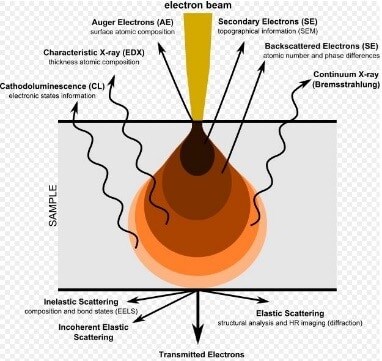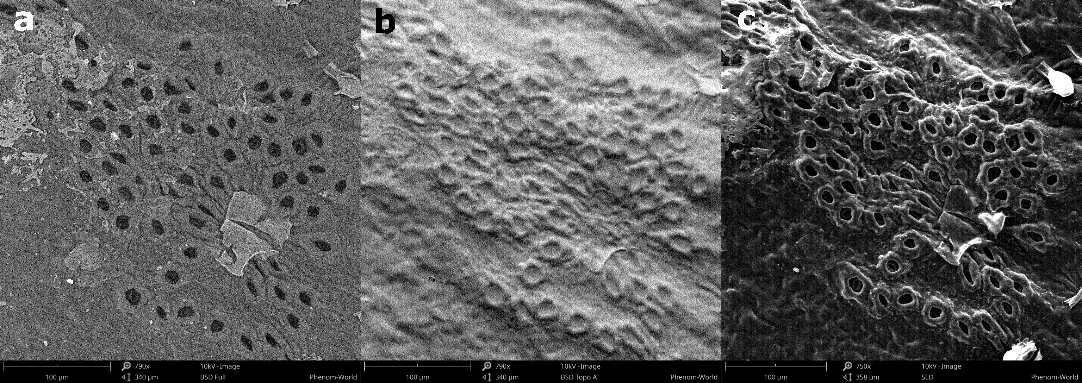Electron microscopes are versatile instruments that can provide a wide range of information depending on the user’s needs. As the name implies, electron microscopes employ an electron beam for imaging. Different signals result between interaction between electrons and matter, each of which carry useful information about the sample. It’s the choice of the microscope’s operator which signals to capture.
Types of SEM signals
For example, in transmission electron microscopy (TEM), as the name suggests, signals such as the transmitted electrons are detected which give information on the sample’s inner structure. In the case of a scanning electron microscope (SEM), two types of electrons are typically detected: backscattered electrons (BSEs) and secondary electrons (SEs).
BSEs are reflected back after elastic interactions between the beam and the sample. By contrast, SEs originate from the atoms of the sample; they are a result of inelastic interactions between the electron beam and the sample.
Comparison of SEM signals
BSEs come from deeper regions of the sample, whereas SE originate from surface regions. Thus, the two carry different types of information. BSE images show high sensitivity to differences in atomic number; the higher the atomic number, the brighter the material appears in the image. SE imaging can provide more detailed surface information.

Electron – matter interactions: the different types of signals generated
Backscattered Electron Imaging
BSEs originate from a broad region within the interaction volume. They are a result of elastic collisions of electrons with atoms, which result in a change in the electrons’ trajectories. Think of the electron-atom collision as the so-called “billiard-ball” model, where small particles (electrons) collide with larger particles (atoms). Larger atoms are much stronger scatterers of electrons than light atoms, and therefore produce a higher signal. The number of the backscattered electrons reaching the detector is proportional to their atomic number. This dependence of the number of BSEs on the atomic number helps us differentiate between different phases, providing imaging that carries information on the sample’s composition. BSE images can also provide valuable information on crystallography, topography, and the magnetic field of the sample.

a) SEM image of an Al/Cu sample, b) and c) Simplified illustration of the interaction between an electron beam with aluminum and copper. Copper atoms (higher atomic number) scatter more electrons back towards the detector than the lighter aluminum atoms and therefore appear brighter in the SEM image.
The most common BSE detectors are solid state detectors, which typically contain p-n junctions. The working principle is based on the generation of electron-hole pairs by the backscattered electrons which escape the sample and are absorbed by the detector. The number of these pairs depends on the energy of the backscattered electrons. The p-n junction is connected to two electrodes, one of which attracts the electrons and the other the holes, thereby generating an electrical current, which also depends on the quantity of absorbed backscattered electrons.
The BSE detectors are placed above the sample, concentrically to the electron beam in a “doughnut” arrangement to maximize the collection of the backscattered electrons. When all parts are enabled, the contrast of the image depicts the atomic number of the element. When only specific quadrants of the detector are enabled, topographical information from the image can be retrieved.

Typical position of the backscattered and secondary electron detectors.
Secondary Electrons
Unlike BSEs, SEs originate from the surface or the near-surface regions of the sample. They are a result of inelastic interactions between the primary electron beam and the sample and have lower energy than the backscattered electrons. Secondary electrons are very useful for the inspection of the topography of the sample’s surface.
The Everhart-Thornley detector is the most frequently used device for the detection of SEs. It consists of a scintillator inside a Faraday cage, which is positively charged and attracts the SEs. The scintillator is then used to accelerate the electrons and convert them into light before reaching a photomultiplier for amplification. The SE detector is placed at the side of the electron chamber, at an angle, to increase the efficiency of detecting secondary electrons.

a) Full backscattered electron detector (BSD), b) topography BSD and c) secondary electron detector images of a leaf.
BSEs and SEs are the most commonly used signals by SEM users for imaging. Because researchers often seek different kinds of data, having multiple detectors makes SEM a very versatile tool that can provide valuable information for many different applications.
Learn how SEM can enhance your research by downloading the free SEM working principle whitepaper.
To learn more about the types of electrons used in scanning electron microscopy, fill out this form to speak with an expert.
Antonis Nanakoudis is an application engineer for the Phenom Desktop SEM family of products at Thermo Fisher Scientific.

Leave a Reply